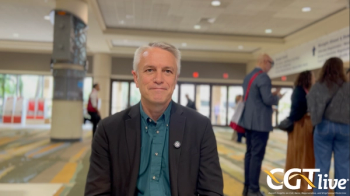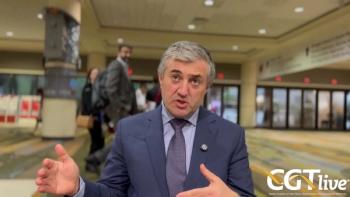
mHA-Specific Donor Tregs Show Potential in Preventing GvHD in Donor HCT
The expanded donor Treg clones maintained lineage fidelity and were persistent through 1 year post-HCT.
Minor histocompatibility antigen (mHA)-specific donor regulatory T cells (Treg cells) may have potential in preventing graft-versus-host disease (GvHD) in patients receiving matched related donor allogeneic
These data were presented by Joseph Pidala, MD, PhD, blood and marrow transplant department, Moffitt Cancer Center, and Associate Professor of Oncology, University of South Florida, at
“We know the GvHD is common despite our commonly used pharmacologic immune-suppressive prophylaxis strategies. It can be a threat to the curative potential of transplant by way of morbidity and mortality associated with acute GvHD, refractoryness [sic], [and] complications of acute GvHD. In the context of matched sibling donor transplants, acute GvHD can occur despite the matching between the donor and recipient due to the donor T-cell recognition of mHAs,” Pidala said during his presentation.
Pidala and colleagues built on previous work that demonstrated expansion of mHA-specific Tregs from the blood and from large volume apheresis procedures that preserve antigen specific suppressive function and FoxP3 TSDR demethylation. The end of expansion cultured conventional T-cells (Tcons) were anergic.
READ MORE:
“We developed a refined procedure for clinical application. This involves a single step TD25 enrichment as well as coculture with recipient 2 dendritic cells, IL-2, IL-15, and rapamycin, and have demonstrated the end expansion product as a highly pure Treg product with limited contamination from other immune cells,” Pidala said.
Pidala and colleagues evaluated the Tregs in 15 participants that had hematologic malignancy in remission, met HCT eligibility, and had human leukocyte antigen (HLA)-matched sibling donors. The participants had a median age of 51 years (range, 31-68) and had hematologic malignancies including acute myeloid leukemia (AML, n = 10), acute lymphoblastic leukemia (ALL, n = 3), myelodysplastic syndrome (n = 1), and non-Hodgkin lymphoma (n = 1). Eleven underwent a busulfan/fludarabine conditioning regimen and 4 underwent a fludarabine/melphalan regimen.
The patients receiving HCT underwent apheresis for generation of dendritic cells (DC), and donors underwent apheresis followed by single-step Miltenyi CD25+ Treg enrichment. The DC:Tregs were cocultured with rapamycin, IL-2 and IL-15 under GMP conditions for 12 days followed by the final Treg infusion 2 days before patients received unmanipulated donor peripheral blood stem cell (PBSC)grafts. Patients also received sirolimus and tacrolimus.
Three patients were in each of the first 3 cohorts and received 0.5 x 105 cells/kg, 1 x 105 cells/kg, and 2 x 105 cells/kg; and 6 patients received the fourth dose level of 4 x 105 cells/kg. Three pairs were enrolled but not treated due to sepsis, relapse, or release criteria not being met (n = 1 each).
The investigators did not observe any dose-limiting toxicities and the adverse event (AE) profile was consistent with the usual post-HCT toxicities. Dose level 4 was identified as the maximum tolerated dose. There were 2 infusion reactions of grade 2 urticaria in 1 patient each in cohorts 1 and 2. There was no evidence of prolonged engraftment, poor donor chimerism, increased infectious risk, or excess relapse.
Post HCT, Tregs exceeded activated CD4 Tcon cells. The median follow-up for survivors was 41.7 months (range, 14.5-72.9) and overall survival was 73% (95% CI, 54-100%). The day 100 cumulative incidence of grade 2-4 acute GvHD was 13% (95% CI, 2-35). The rate of moderate/severe chronic GvHD by 1 year was 6.7% (95% CI, 0.36-27) and by 3 years was 20% (95%CI, 4.4-44). There were 3 relapse events (2 ALL, 1 AML) and 1 non-relapse death due to pneumonia (dose level 1, during GvHD therapy).
Pidala and colleagues found that the expanded donor Treg clones maintained lineage fidelity in culture and post-HCT. They persisted and expanded in vivo through 1 year post-HCT according to TCR sequencing data.
“In conclusion, we’ve demonstrated here that mHA-specific Tregs can be expanded. The intent of this study was to expand them to rival the expected content of mHA-specific Tcon in a conventional PBSC product. This phase 1 supports that Treg adoptive therapy in matched sibling donor transplants is safe. Acknowledging that this is a phase 1 study and not powered for clinical efficacy, it does provide some glimpse of initial efficacy that is encouraging,” Pidala concluded. “We do have some prior and ongoing work focused on the phenotype and function of these Tregs when isolated from the peripheral blood post transplant.”
REFERENCE
Pidala J, Betts BC. Schell M, et al. Expanded Antigen-Specific Donor Regulatory T Cells for Gvhd Prevention. Presented at: 2024 Tandem Meetings, February 21-24, San Antonio, Texas. Abstract #32
Newsletter
Stay at the forefront of cutting-edge science with CGT—your direct line to expert insights, breakthrough data, and real-time coverage of the latest advancements in cell and gene therapy.




































